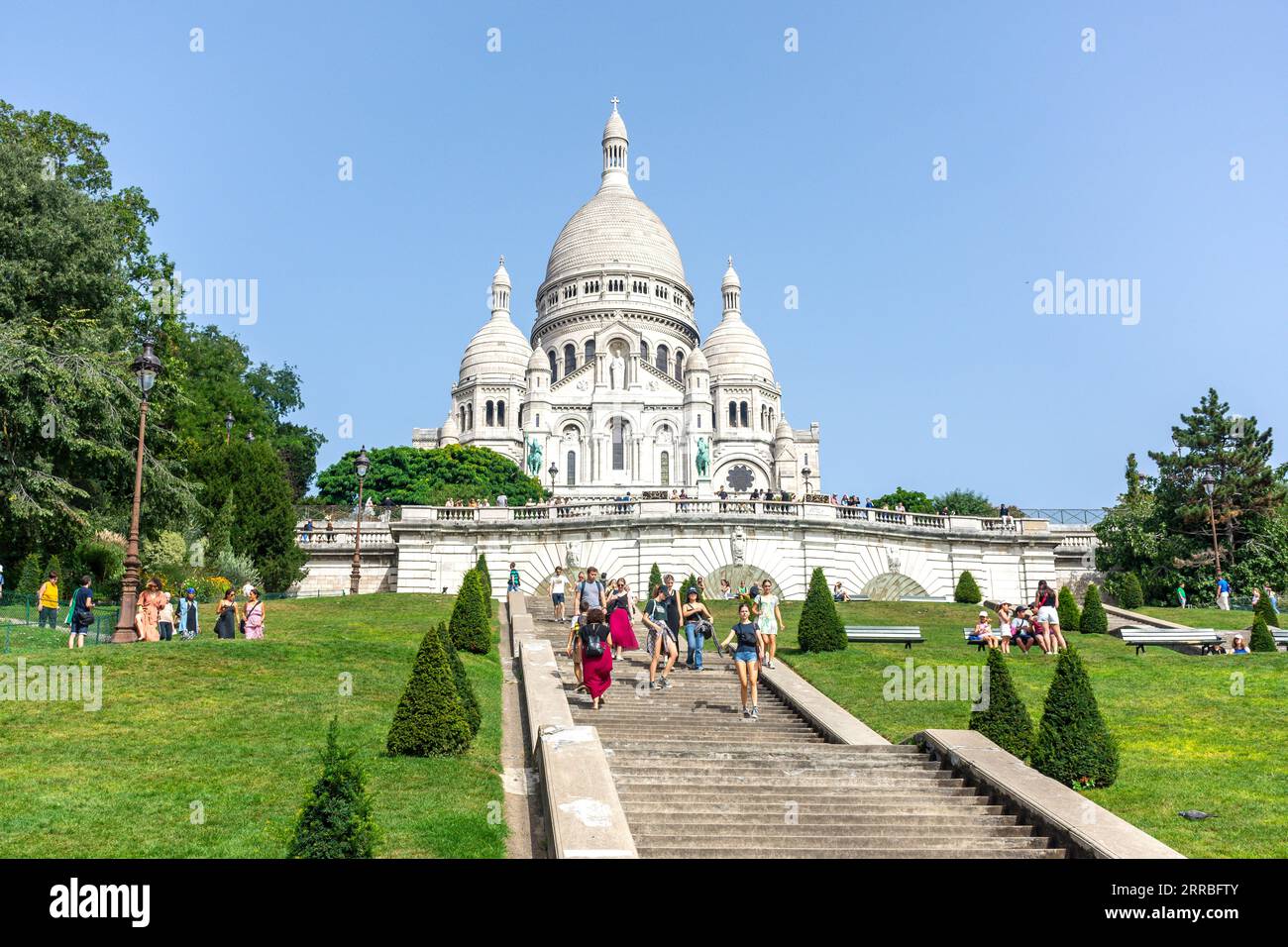The Basilica of the Sacred Heart of Montmartre, commonly known as Sacré-Cœur Basilica, is an iconic landmark perched atop Montmartre, the highest point in Paris. Its gleaming white dome, visible from across the city, is a symbol of hope, faith, and national penance. More than just a stunning architectural marvel, the basilica is steeped in history, spiritual significance, and artistic brilliance. This article delves into the design, history, and enduring allure of the Sacré-Cœur.
A History Born from Tumultuous Times:
The story of the Sacré-Cœur begins in the aftermath of the Franco-Prussian War (1870-1871), a devastating conflict for France. The nation was deeply shaken, and many attributed the defeat to moral and spiritual failings. Alexandre Legentil, a devout Catholic businessman, made a vow to build a church dedicated to the Sacred Heart of Jesus if France was spared further devastation. He believed this act of penance would help restore the nation’s spiritual strength and heal its wounds.
His proposal gained traction, and the National Assembly officially sanctioned the project in 1873, declaring it a national vow. This decision, however, was not without controversy. Many republicans and secularists viewed the basilica as a symbol of the conservative, royalist faction, associating it with the defeat of the Paris Commune and the restoration of monarchical power. Despite the opposition, the project moved forward, fueled by public donations and the strong support of the Catholic Church.
The Design: A Romano-Byzantine Masterpiece:
The design of the Sacré-Cœur was entrusted to Paul Abadie, who won a competition against nearly 80 other architects. Abadie envisioned a basilica in the Romano-Byzantine style, drawing inspiration from architecture found in Italy and the Byzantine Empire. This style, characterized by its rounded arches, domes, and intricate mosaics, was seen as a deliberate departure from the Gothic style prevalent in many other Parisian churches, symbolizing a new era of hope and renewal.
-
The Exterior: The basilica is constructed from Château-Landon stone, a unique travertine that hardens over time and bleaches white in contact with rainwater. This gives the Sacré-Cœur its distinctive, luminous appearance. The imposing facade features three arches, each adorned with bronze doors depicting scenes from the life of Christ. Above the arches, two equestrian statues flank a central figure of Christ displaying his Sacred Heart. These statues represent Joan of Arc and King Saint Louis IX, both national heroes symbolizing faith and patriotism.
-
The Dome: The most prominent feature of the Sacré-Cœur is its magnificent dome, rising 83 meters (272 feet) above the ground. Visitors can climb to the top of the dome for panoramic views of Paris, stretching as far as the eye can see. This breathtaking vista offers a unique perspective on the city’s layout and its many iconic landmarks.
-
The Interior: The interior of the basilica is just as impressive as its exterior. The vast nave is bathed in soft light filtering through stained-glass windows, creating a serene and spiritual atmosphere. The focal point of the interior is the apse, which houses one of the world’s largest mosaics.
The Great Mosaic: Christ in Majesty:
The mosaic, titled "Christ in Majesty," is a stunning masterpiece spanning over 475 square meters (5,113 square feet). It depicts Jesus Christ with outstretched arms, offering his Sacred Heart to humanity. He is surrounded by saints, angels, and figures representing the Church and France. The mosaic’s vibrant colors and intricate details are truly awe-inspiring, conveying a powerful message of love, compassion, and redemption.
The Crypt: A Place of Contemplation:
Beneath the main basilica lies a vast crypt, larger than the church itself. The crypt houses statues of saints and benefactors, as well as the tombs of prominent figures associated with the Sacré-Cœur. The atmosphere in the crypt is one of quiet contemplation and reverence, offering visitors a chance to reflect on the basilica’s history and spiritual significance.
The Bell Tower: La Savoyarde:
The Sacré-Cœur also boasts a bell tower, which houses "La Savoyarde," one of the world’s heaviest bells. Cast in 1895 in Annecy, it weighs nearly 19 tons and is named in honor of the Savoy region, which was annexed by France in 1860. La Savoyarde is only rung on special occasions, its deep, resonant tones echoing across the city.
The Sacré-Cœur Today: A Place of Pilgrimage and Prayer:
The construction of the Sacré-Cœur took over 40 years, finally being completed in 1914, just before the outbreak of World War I. Consecrated in 1919, the basilica quickly became a major pilgrimage site, attracting millions of visitors each year. Today, the Sacré-Cœur remains a place of active worship, with daily Masses, adoration, and prayer services.
Beyond the Religious Significance:
While the Sacré-Cœur holds immense religious significance, it is also a cultural and artistic treasure. Its architectural beauty, stunning mosaics, and panoramic views make it a must-see destination for anyone visiting Paris. The basilica is a symbol of the city’s resilience, its artistic heritage, and its enduring spirit.
Exploring Montmartre:
A visit to the Sacré-Cœur is often combined with exploring the charming neighborhood of Montmartre. Known for its artistic history, Montmartre was once home to famous painters such as Picasso, Van Gogh, and Renoir. Today, the neighborhood retains its bohemian atmosphere, with artists displaying their work in the Place du Tertre, a bustling square just steps away from the basilica.
Practical Information for Visitors:
- Location: The Sacré-Cœur is located at the summit of Montmartre, in the 18th arrondissement of Paris.
- Getting There: The easiest way to reach the basilica is by taking the funicular from the base of Montmartre. Alternatively, visitors can climb the steps, enjoying the scenic views along the way.
- Opening Hours: The basilica is open daily from morning to evening.
- Admission: Admission to the basilica is free. However, there is a fee to climb to the top of the dome.
- Dress Code: As a place of worship, visitors are asked to dress respectfully.
In Conclusion:
The Basilica of the Sacred Heart of Montmartre is more than just a beautiful building; it is a symbol of faith, hope, and national penance. Its history is intertwined with the tumultuous events of 19th-century France, and its design reflects a desire for renewal and spiritual healing. Whether you are drawn to its religious significance, its artistic beauty, or its stunning views, the Sacré-Cœur is a truly unforgettable experience. A visit to this iconic landmark is a journey into the heart of Paris, offering a glimpse into its rich history, its artistic soul, and its enduring spirit.


